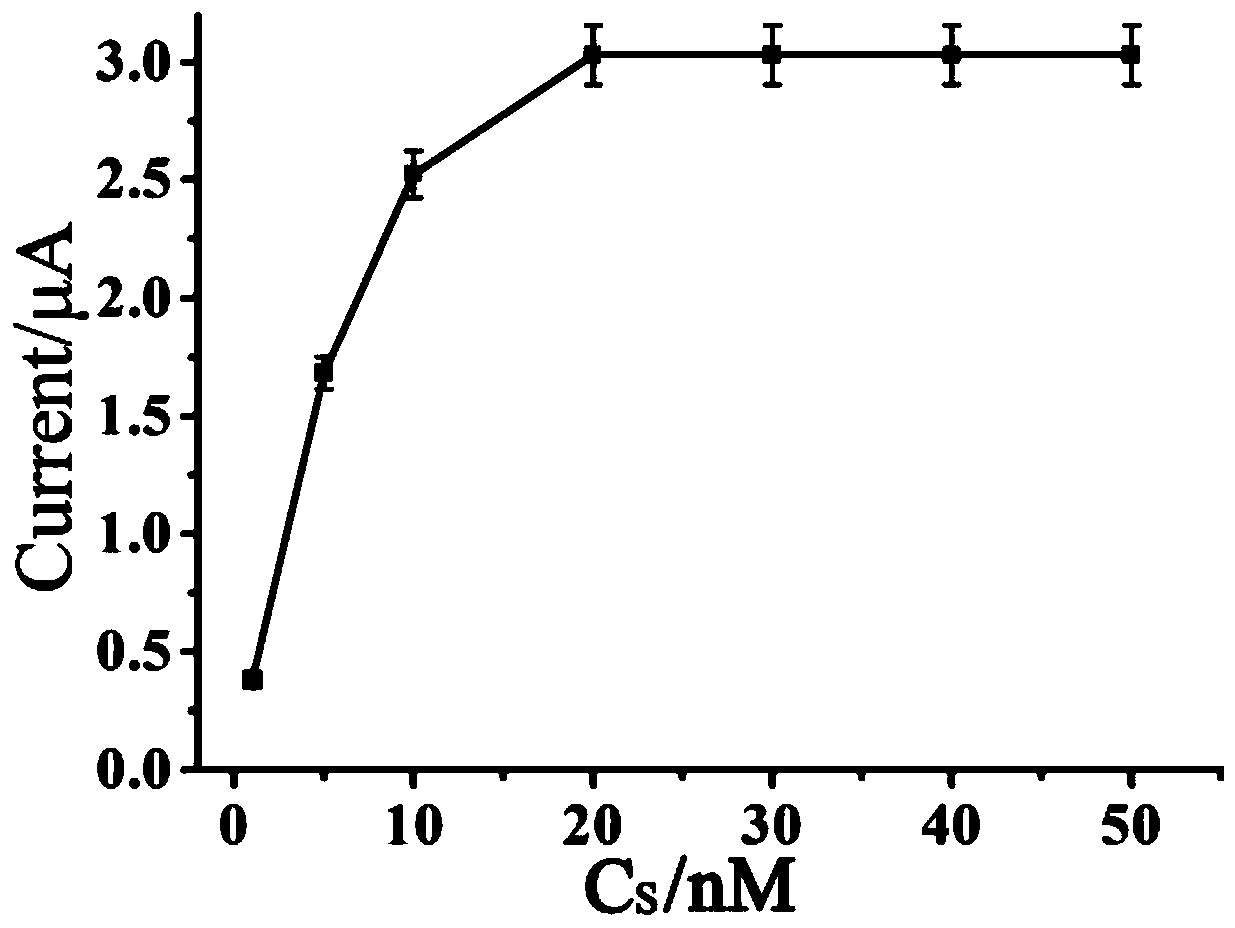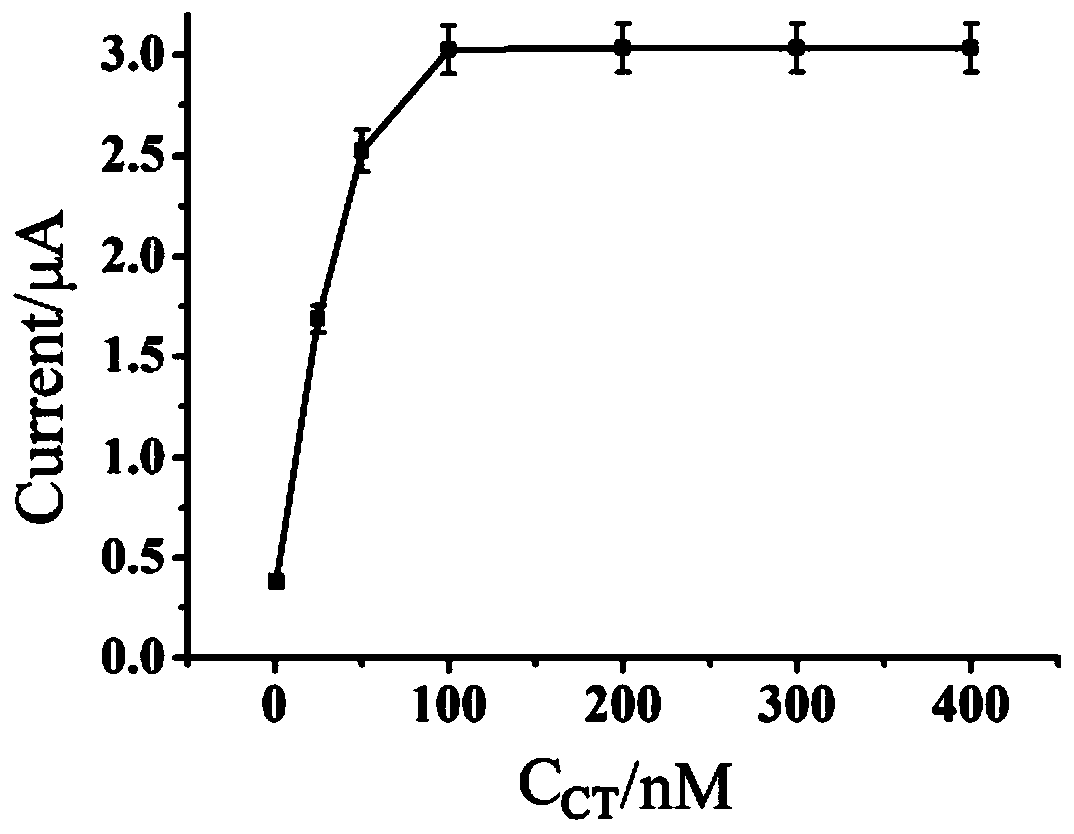Electrochemical biosensor for detecting miRNA as well as preparation method and application of electrochemical biosensor
A biosensor, electrochemical technology, applied in biochemical equipment and methods, material electrochemical variables, scientific instruments, etc., can solve the problems of complicated instrument operation and expensive equipment, and achieve high sensitivity detection, low detection limit, and detection speed. quick effect
- Summary
- Abstract
- Description
- Claims
- Application Information
AI Technical Summary
Problems solved by technology
Method used
Image
Examples
Embodiment 1
[0062] Example 1 Preparation of circular template and silver nanoclusters
[0063] (1) Mix 42 μL sterilized water, 6 μL linear template (100 μM), 6 μL ligation probe (100 μM) and 6 μL 10× T4 DNA ligase buffer, denature at 95°C for 5 min, then slowly Slowly cool down to room temperature to complete the hybridization, then add 3 μL T4 DNA ligase (60 U / μL) to the reaction system, and react at 16°C for 20 hours; after that, the reaction system is placed in a water bath at 65°C for 15 minutes, Inactivate T4 DNA ligase in the system.
[0064] (2) Add 1 μL of exonuclease Ⅰ (20 U / μL) and 2 μL of exonuclease Ⅲ (100 U / μL) to the above reaction system and react at 37°C for 2 h; then put the reaction system at 85°C Heated in a water bath for 10 min to obtain a circular template, which was stored at 4°C for future use.
[0065] (3) Mix 15 μL, 100 μM AgMBs nucleic acid sequence with 73 μL of 20 mM phosphate buffer solution (pH=7.0), and then add 6 μL, 1.5 mM AgNO3 solution into the system...
Embodiment 2
[0067] Example 2 Variation of electrochemical signal with S concentration
[0068] A preparation method of the electrochemical biosensor of the present invention, comprising the following steps:
[0069] a. The gold electrode is first polished in 0.3 and 0.05 µM alumina slurry until it becomes a mirror surface, and then rinsed repeatedly with PBS and secondary water;
[0070] b. Take 121 µL sterilized water, 44 µL 5×PBS buffer, 44 µL TCEP (10 µM), 11 µL S1 chain (2 µM) in a sterilized centrifuge tube;
[0071] c. Add 10 μL of the solution in step b to the surface of the electrode dropwise, incubate at 37 °C for 2 h, and wash.
[0072] So far, the modification process of the electrode has come to an end. The following describes the reaction in the homogeneous solution and the main steps in the homogeneous reaction:
[0073] a. Take 10 μL of 10×phi29 DNA polymerase reaction buffer, 10 μL of 10×RCA buffer, 5 μL of circular template (100 nM) and 2 μL of AgMBs (500 nM), 5 μL of S...
Embodiment 3
[0078] Example 3 Variation of electrochemical signal with concentration of cyclic template
[0079] A preparation method of the electrochemical biosensor of the present invention, comprising the following steps:
[0080] a. The gold electrode is first polished in 0.3 and 0.05 µM alumina slurry until it becomes a mirror surface, and then rinsed repeatedly with PBS and secondary water;
[0081] b. Take 121 µL sterilized water, 44 µL 5×PBS buffer, 44 µL TCEP (10 µM), 11 µL S1 chain (50 nM) in a sterilized centrifuge tube;
[0082] c. Add 10 μL of the solution in step b dropwise to the surface of the electrode, incubate at 37°C for 2 h, and wash.
[0083] So far, the modification process of the electrode has come to an end. The following describes the reaction in the homogeneous solution and the main steps in the homogeneous reaction:
[0084] a. Take 10 μL of 10×phi29 DNA polymerase reaction buffer, 10 μL of 10×RCA buffer, and 5 μL of circular template (concentrations are 0 nM,...
PUM
 Login to View More
Login to View More Abstract
Description
Claims
Application Information
 Login to View More
Login to View More - R&D
- Intellectual Property
- Life Sciences
- Materials
- Tech Scout
- Unparalleled Data Quality
- Higher Quality Content
- 60% Fewer Hallucinations
Browse by: Latest US Patents, China's latest patents, Technical Efficacy Thesaurus, Application Domain, Technology Topic, Popular Technical Reports.
© 2025 PatSnap. All rights reserved.Legal|Privacy policy|Modern Slavery Act Transparency Statement|Sitemap|About US| Contact US: help@patsnap.com



